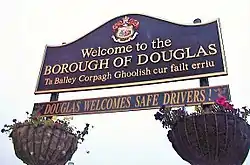Languages of the Isle of Man
The main language of the Isle of Man is English, predominantly the Manx English dialect. Manx, the historical language of the island, is still maintained by a very small speaker population.
| Languages of Isle of Man | |
|---|---|
| Main | English (Manx English) |
| Immigrant | Irish |
| Foreign | French, German |
| Revived national language(s) | Manx |
Both English and Manx are official languages in Tynwald.
Manx

The Manx language is a Celtic language of the Goidelic subdivision, and descendant of Old Irish. It is sometimes called Manx Gaelic to distinguish it from the local variety of English.
The language was historically the dominant one on the island, but fell out of use during the twentieth century. Following the death of Ned Maddrell in 1974, Manx is now considered to be "critically endangered".[1] At the present time, less than one hundred children receive their education exclusively in Manx. There are an additional 1,689 second-language speakers, comprising 2.2% of the population of the Isle of Man. The language has been offered in public schools since 1992, and has been mandatory since 2001.
English language
The English language has replaced Manx as the dominant language on the island. The native dialect is known as Anglo-Manx or Manx English, and has been employed by a number of the island's more notable writers such as T.E. Brown and "Cushag". which distinguishes itself by considerable influence and a large number of loanwords and phrases from Manx Gaelic. However, this dialect is being supplanted by other dialects of English, especially from north west England.
For formal purposes British English is the usual form of English used in the Isle of Man. For many years, the BBC has been the main broadcaster to the island, and many English people have settled in the IOM.
Forms of Irish English can also be heard on the island, from both Dublin and Belfast. The island has traditionally had many Irish tourists, and settlers.
Other minority languages
There are a few people in the island who speak other languages habitually. These include Irish speakers.
Extinct languages of the Isle of Man

Historical forms of "Irish"
Old Irish and Middle Irish are the ancestors of today's Manx language. Neither of these became extinct, so much as evolved, and Manx diverged from Scottish and Irish forms.
During the Middle Ages, the three Gaelic languages maintained a single standard for higher registers and poetry. This is sometimes misleadingly referred to as "Classical Irish" - despite the fact it was much in use in Scotland and presumably the Isle of Man. It is also known as Classical Gaelic.
Old Norse
Many of the island's placenames are Norse in origin, e.g. Laxey, Ramsey, and so are some of the island's institutions e.g. Tynwald (Þingvóllr). A few Norse inscriptions remain.
Brythonic
There seems to be evidence that the island once spoke a form of P-Celtic before it became Gaelicised. There is little evidence of this in placenames however.
References
- "Manx Gaelic 'not extinct' says UN". BBC. 19 August 2009. Retrieved 13 August 2020.